Ecoacoustic Baseline of a Successional Subarctic Ecosystem Post-Glaciation Amidst Climate Change in South-Central Alaska
Abstract
1. Introduction
1.1. Sonic Indicators of Ecological Change: An Ecoacoustics Approach
1.2. Ecoacoustic Baselines Amidst Climate Change
- Record ambient sounds during the tourist season at distances from a road where tourist vehicle numbers are counted within a highly visited region of an Alaskan national park effected by climate change,
- Calculate ecoacoustic indices from these recordings to quantify the sonoscape as an indicator of the geophysical, biological, and anthropogenic activities in this study area,
- Determine whether there is a measurable spatial difference of ecoacoustic indices at interval distances from the road, and
- Visualize the temporal patterns of the sonoscape at annual, monthly, daily, and hourly timescales as an ecoacoustic baseline for future comparisons.
2. Materials and Methods
2.1. Study Area
2.2. Sample Design
2.3. Sound Sampling
2.4. Ecoacoustic Indices
2.4.1. Sonic Heterogeneity Index
2.4.2. Spectral Sonic Signature
2.4.3. Weighted Proportion of Occupied Frequencies
2.4.4. Normalized Difference Sonic Heterogeneity Index
3. Results
3.1. Annual Spatio-Temporal Patterns of SSS and NDSHI
3.2. Monthly Spatio-Temporal Patterns of wPOFm and NDSHI
3.3. Daily Spatio-Temporal Patterns of wPOFd and NDSHI
3.4. Hourly Spatio-Temporal Patterns of wPOFt and NDSHI
4. Discussion
4.1. Spatial Variation of the Sonoscape
4.2. Temporal Dynamics and Sonophenology
4.3. Geophonic Ambience and Silent Acoustic Niches
4.4. Climate Change Implications
5. Conclusions
Author Contributions
Funding
Institutional Review Board Statement
Data Availability Statement
Acknowledgments
Conflicts of Interest
References
- Hayward, G.D.; Colt, S.; McTeague, M.L.; Hollingsworth, T.N. Climate Change Vulnerability Assessment for the Chugach National Forest and the Kenai Peninsula; Gen. Tech. Rep. PNW-GTR-950; USDA Forest Service, Pacific Northwest Research Station: Portland, OR, USA, 2017. [Google Scholar]
- Shulski, M.; Wendler, G. The Climate of Alaska; University of Alaska Press: Fairbanks, AK, USA, 2007; p. 208. [Google Scholar]
- VanLooy, J.; Forster, R.; Ford, A. Accelerating thinning of Kenai Peninsula glaciers, Alaska. Geophys. Res. Lett. 2006, 33. [Google Scholar] [CrossRef]
- Yang, R.; Hock, R.; Kang, S.; Shangguan, D.; Guo, W. Glacier mass and area changes on the Kenai Peninsula, Alaska, 1986–2016. J. Glaciol. 2020, 66, 603–617. [Google Scholar] [CrossRef]
- Yang, R.; Hock, R.; Kang, S.; Guo, W.; Shangguan, D.; Jiang, Z.; Zhang, Q. Glacier surface speed variations on the Kenai Peninsula, Alaska, 2014–2019. J. Geophys. Res. Earth Surf. 2022, 127, e2022JF006599. [Google Scholar] [CrossRef]
- Black, T.; Kurtz, D. Maritime glacier retreat and terminus area change in Kenai Fjords National Park, Alaska, between 1984 and 2021. J. Glaciol. 2023, 69, 251–265. [Google Scholar] [CrossRef]
- Yu, G.; Schwartz, Z.; Walsh, J.E. Effects of climate change on the seasonality of weather for tourism in Alaska. Arctic 2009, 62, 443–457. [Google Scholar] [CrossRef]
- Lenzen, M.; Sun, Y.Y.; Faturay, F.; Ting, Y.P.; Geschke, A.; Malik, A. The carbon footprint of global tourism. Nat. Clim. Chang. 2018, 8, 522–528. [Google Scholar] [CrossRef]
- Stone, R.S.; Dutton, E.G.; Harris, J.M.; Longenecker, D. Earlier spring snowmelt in northern Alaska as an indicator of climate change. J. Geophys. Res. Atmos. 2002, 107, ACL-10. [Google Scholar] [CrossRef]
- Adam, J.C.; Hamlet, A.F.; Lettenmaier, D.P. Implications of global climate change for snowmelt hydrology in the twenty-first century. Hydrol. Process. 2009, 23, 962–972. [Google Scholar] [CrossRef]
- Wipf, S.; Stoeckli, V.; Bebi, P. Winter climate change in alpine tundra: Plant responses to changes in snow depth and snowmelt timing. Clim. Change 2009, 94, 105–121. [Google Scholar] [CrossRef]
- Buxton, R.T.; Brown, E.; Sharman, L.; Gabriele, C.M.; McKenna, M.F. Using bioacoustics to examine shifts in songbird phenology. Ecol. Evol. 2016, 6, 4697–4710. [Google Scholar] [CrossRef]
- Oliver, R.Y.; Ellis, D.P.; Chmura, H.E.; Krause, J.S.; Pérez, J.H.; Sweet, S.K.; Gough, L.; Wingfield, J.C.; Boelman, N.T. Eavesdropping on the Arctic: Automated bioacoustics reveal dynamics in songbird breeding phenology. Sci. Adv. 2018, 4, eaaq1084. [Google Scholar] [CrossRef] [PubMed]
- Jorgensen, S.E. Introduction to Systems Ecology; CRC Press: Boca Raton, FL, USA, 2016. [Google Scholar]
- Farina, A.; Li, P. An introduction to ecoacoustics. In Methods in Ecoacoustics: The Acoustic Complexity Indices; Springer International Publishing: Cham, Switzerland, 2022; pp. 1–29. [Google Scholar]
- Sueur, J.; Farina, A. Ecoacoustics: The ecological investigation and interpretation of environmental sound. Biosemiotics 2015, 8, 493–502. [Google Scholar] [CrossRef]
- Farina, A.; Mullet, T.C.; Bazarbayeva, T.A.; Tazhibayeva, T.; Polyakova, S.; Li, P. Sonotopes reveal dynamic spatio-temporal patterns in a rural landscape of Northern Italy. Front. Ecol. Evol. 2023, 11, 1205272. [Google Scholar] [CrossRef]
- Gonzalez, P.; Wang, F.; Notaro, M.; Vimont, D.J.; Williams, J.W. Disproportionate magnitude of climate change in United States national parks. Environ. Res. Lett. 2018, 13, 104001. [Google Scholar] [CrossRef]
- Thompson, L.M.; Lynch, A.J.; Beever, E.A.; Engman, A.C.; Falke, J.A.; Jackson, S.T.; Krabbenhoft, T.J.; Lawrence, D.J.; Limpinsel, D.; Magill, R.T.; et al. Responding to ecosystem transformation: Resist, accept, or direct? Fisheries 2021, 46, 8–21. [Google Scholar] [CrossRef]
- Stinchcomb, T.R.; Brinkman, T.J.; Betchkal, D. Extensive aircraft activity impacts subsistence areas: Acoustic evidence from Arctic Alaska. Environ. Res. Lett. 2020, 15, 115005. [Google Scholar] [CrossRef]
- Haver, S.M.; Gustafson, K.B.; Gabriele, C.M. Rapid assessment of vessel noise events and quiet periods in Glacier Bay National Park and Preserve using a convolutional neural net. Environ. Data Sci. 2023, 2, e14. [Google Scholar] [CrossRef]
- Xie, J.; Hu, K.; Zhu, M.; Guo, Y. Data-driven analysis of global research trends in bioacoustics and ecoacoustics from 1991 to 2018. Ecol. Inform. 2020, 57, 101068. [Google Scholar] [CrossRef]
- Farina, A.; Li, P. Methods in Ecoacoustics; Springer International Publishing: Cham, Switzerland, 2021. [Google Scholar]
- Mullet, T.C.; Farina, A.; Morton, J.M.; Wilhelm, S.R. Seasonal sonic patterns reveal phenological phases (sonophases) associated with climate change in subarctic Alaska. Front. Ecol. Evol. 2024, 12, 1345558. [Google Scholar] [CrossRef]
- National Park Service. Frontcountry Management Plan and Environmental Assessment. Kenai Fjords National Park. Available online: https://npshistory.com/publications/kefj/fmp-ea-2024.pdf (accessed on 15 October 2024).
- Federal Highway Administration. Noise Measurement Handbook; Final Report; U.S. Department of Transportation: Washington, DC, USA, 2018; p. 205. [Google Scholar]
- Davis, M.J.M.; Tenpierik, M.J.; Ramírez, F.R.; Perez, M.E. More than just a Green Facade: The sound absorption properties of a vertical garden with and without plants. Build. Environ. 2017, 116, 64–72. [Google Scholar] [CrossRef]
- Pocock, Z.; Lawrence, R.E. How Far into a Forest Does the Effect of a Road Extend? Defining Road Edge Effect in Eucalypt Forests of South-Eastern Australia. 2005. Available online: https://escholarship.org/uc/item/4q576877 (accessed on 15 October 2024).
- Munro, J.; Williamson, I.; Fuller, S. Traffic noise impacts on urban forest soundscapes in south-eastern Australia. Austral Ecol. 2018, 43, 180–190. [Google Scholar] [CrossRef]
- National Park Service. Kenai Fjords National Park: Acoustic Monitoring Report 2008–2009; Natural Resource Technical Report NPS/NRSS/NRTR-2013/798; U.S. Department of the Interior, National Park Service: Washington, DC, USA, 2013; p. 50. [Google Scholar]
- Gage, S.H.; Axel, A.C. Visualization of temporal change in soundscape power of a Michigan lake habitat over a 4-year period. Ecol. Inform. 2014, 21, 100–109. [Google Scholar] [CrossRef]
- Fuller, S.; Axel, A.C.; Tucker, D.; Gage, S.H. Connecting soundscape to landscape: Which acoustic index best describes landscape configuration? Ecol. Indic. 2015, 58, 207–215. [Google Scholar] [CrossRef]
- Lellouch, L.; Pavoine, S.; Jiguet, F.; Glotin, H.; Sueur, J. Monitoring temporal change of bird communities with dissimilarity acoustic indices. Methods Ecol. Evol. 2014, 5, 495–505. [Google Scholar] [CrossRef]
- Farina, A. The acoustic complexity index (ACI): Theoretical foundations, applied perspectives and semantics. Oikos 2025, 2025, e10760. [Google Scholar] [CrossRef]
- Blondel, P.; Dell, B.; Suriyaprakasam, C. Acoustic signatures of shipping, weather and marine life: Comparison of NE Pacific and Arctic Soundscapes. In Proceedings of the Meetings on Acoustics, Online, 5–9 October 2020; AIP Publishing: Melville, NY, USA, 2020; Volume 40. [Google Scholar]
- Sangermano, F. Acoustic diversity of forested landscapes: Relationships to habitat structure and anthropogenic pressure. Landsc. Urban Plan. 2022, 226, 104508. [Google Scholar] [CrossRef]
- Mullet, T.C.; Gage, S.H.; Morton, J.M.; Huettmann, F. Temporal and spatial variation of a winter soundscape in south-central Alaska. Landsc. Ecol. 2016, 31, 1117–1137. [Google Scholar] [CrossRef]
- Kasten, E.P.; Gage, S.H.; Fox, J.; Joo, W. The remote environmental assessment laboratory’s acoustic library: An archive for studying soundscape ecology. Ecol. Inform. 2012, 12, 50–67. [Google Scholar] [CrossRef]
- Morton, E.S. Ecological sources of selection on avian sounds. Am. Nat. 1975, 109, 17–34. [Google Scholar] [CrossRef]
- Terraube, J.; Archaux, F.; Deconchat, M.; Van Halder, I.; Jactel, H.; Barbaro, L. Forest edges have high conservation value for bird communities in mosaic landscapes. Ecol. Evol. 2016, 6, 5178–5189. [Google Scholar] [CrossRef] [PubMed]
- Mullet, T.C.; Morton, J.M.; Gage, S.H.; Huettmann, F. Acoustic footprint of snowmobile noise and natural quiet refugia in an Alaskan wilderness. Nat. Areas J. 2017, 37, 332–349. [Google Scholar] [CrossRef]
- Farina, A.; Mullet, T.C.; Bazarbayeva, T.A.; Tazhibayeva, T.; Bulatova, D.; Li, P. Perspectives on the ecological role of geophysical sounds. Front. Ecol. Evol. 2021, 9, 748398. [Google Scholar] [CrossRef]
- Mace, B.L.; Bell, P.A.; Loomis, R.J. Visibility and natural quiet in national parks and wilderness areas: Psychological considerations. Environ. Behav. 2004, 36, 5–31. [Google Scholar] [CrossRef]
- Manning, R.; Valliere, W.; Hallo, J.; Newman, P.; Pilcher, E.; Savidge, M.; Dugan, D. From landscapes to soundscapes: Understanding and managing natural quiet in the national parks. In Proceedings of the 2006 Northeastern Recreation Research Symposium, Bolton Landing, NY, USA, 9–11 April 2006; Burns, R., Robinson, K., Eds.; Comps.; Gen. Tech. Rep. NRS-P-14. U.S. Department of Agriculture, Forest Service, Northern Research Station: Newtown Square, PA, USA, 2007; Volume 14, pp. 601–606. [Google Scholar]
- Harvey, J. (Ed.) The Quiet Mind: Techniques for Transforming Stress; Himalayan Institute Press: Honesdale, PA, USA, 1988. [Google Scholar]
- Riemer, H.C.; Mates, J.; Ryan, L.; Schleder, B.J. Decreased stress levels in nurses: A benefit of quiet time. Am. J. Crit. Care 2015, 24, 396–402. [Google Scholar] [CrossRef][Green Version]


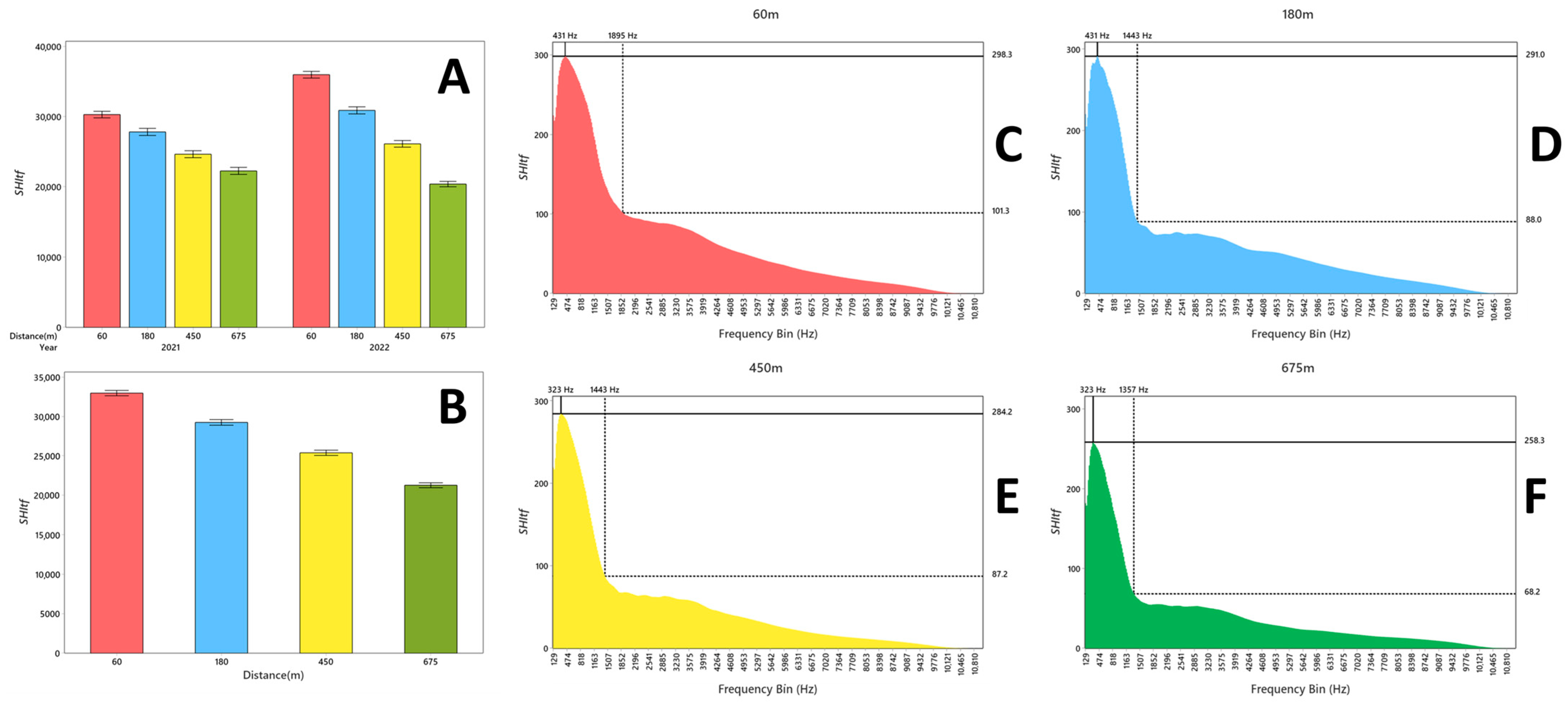
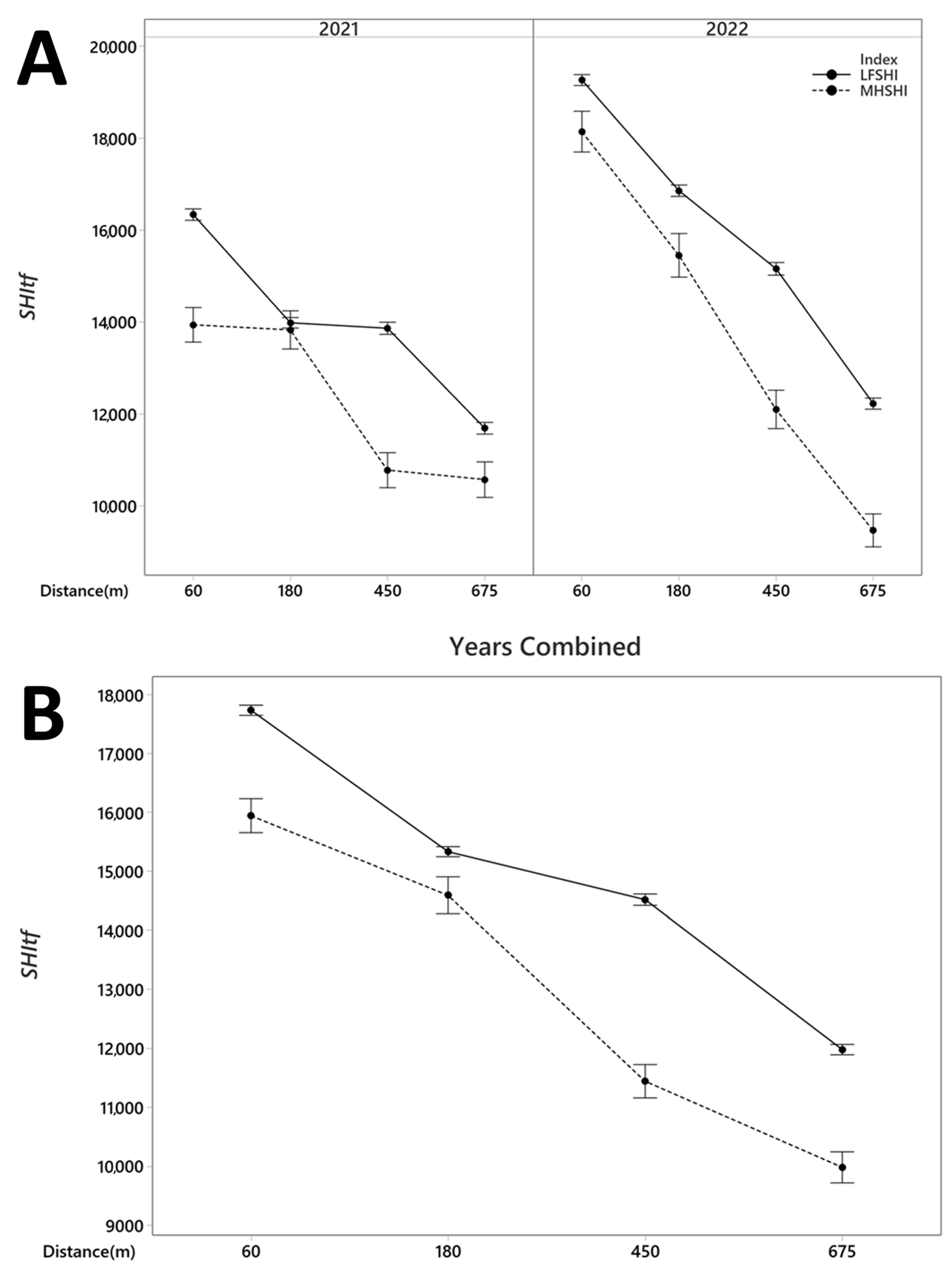
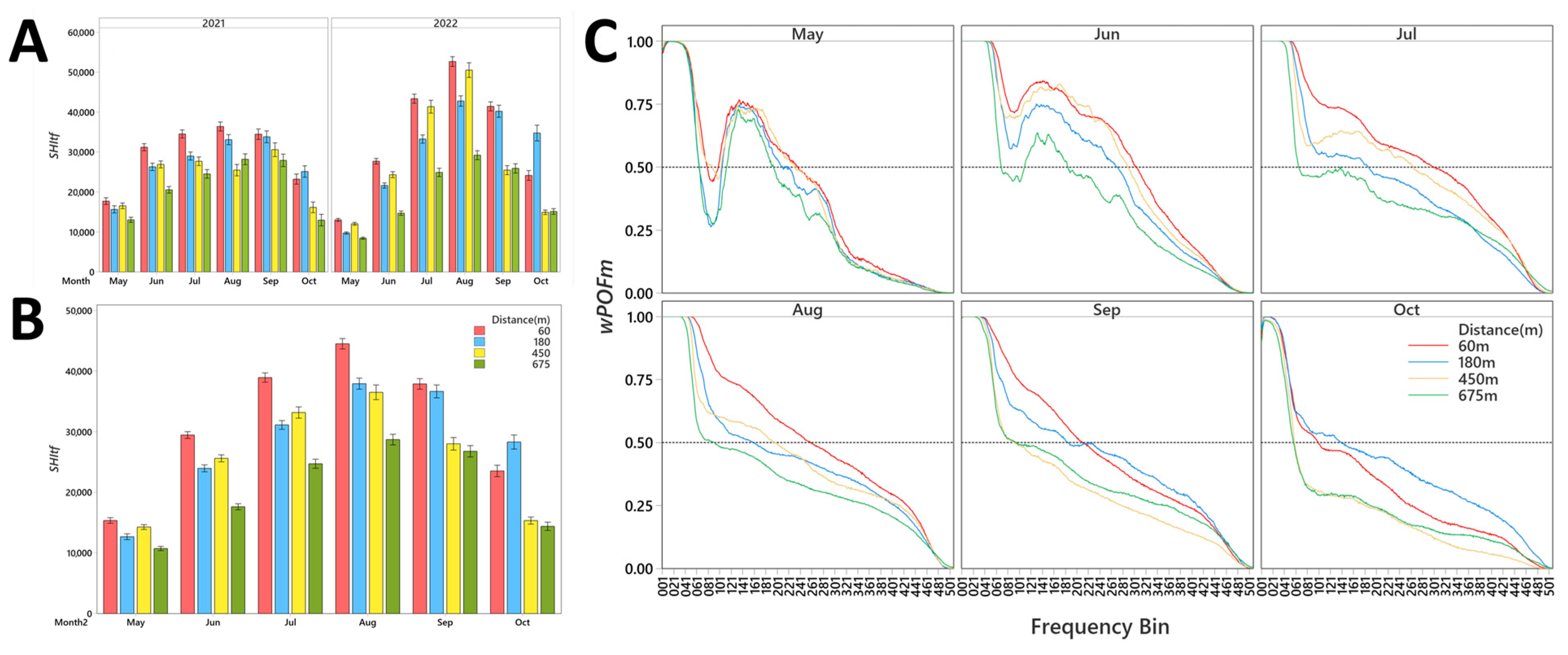
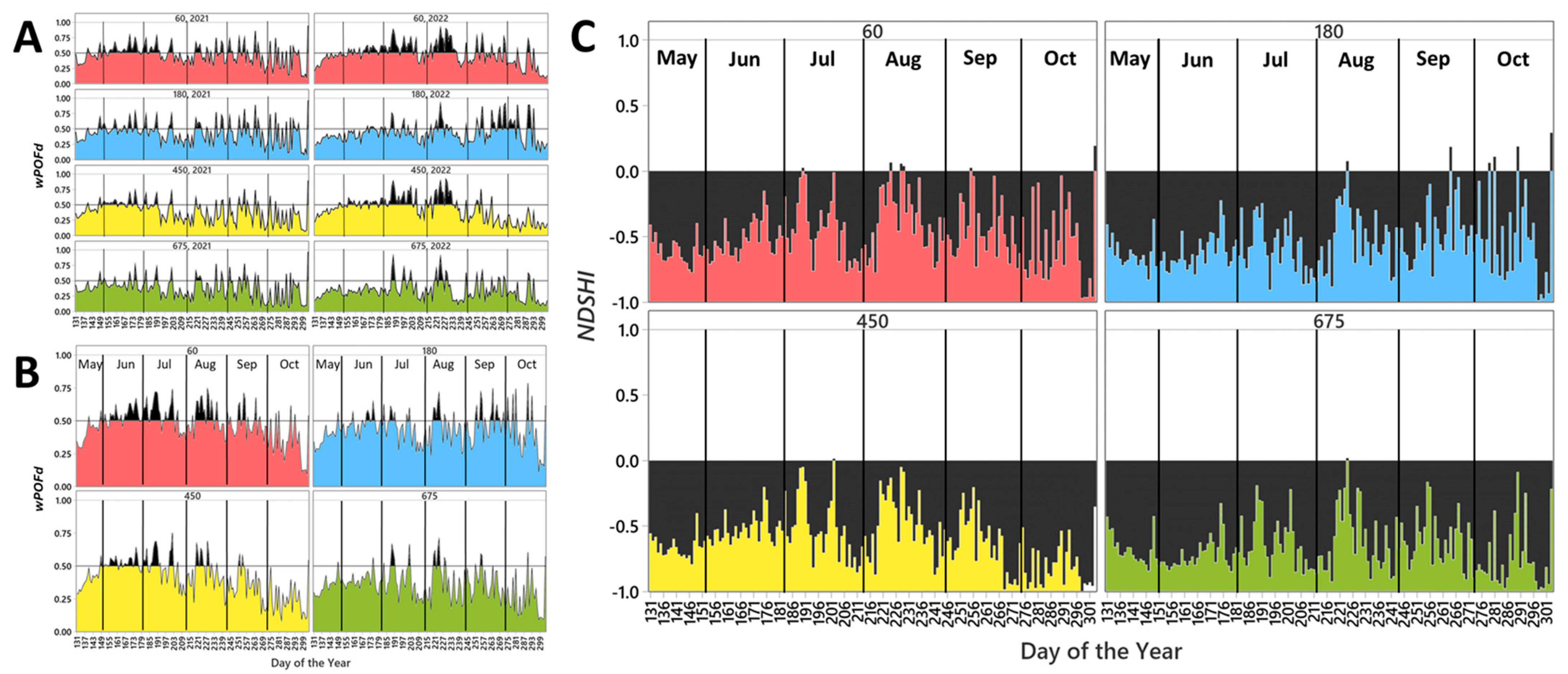
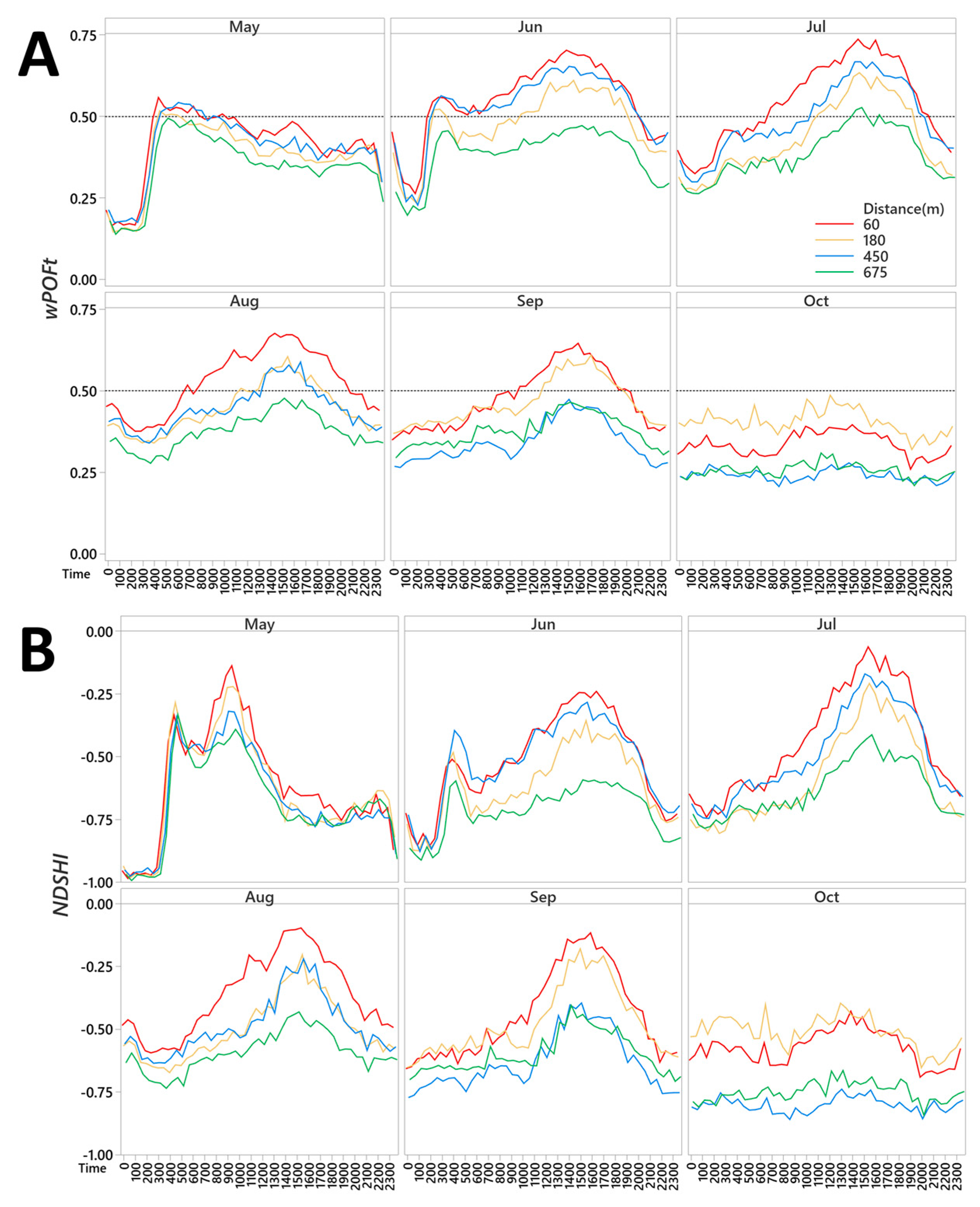
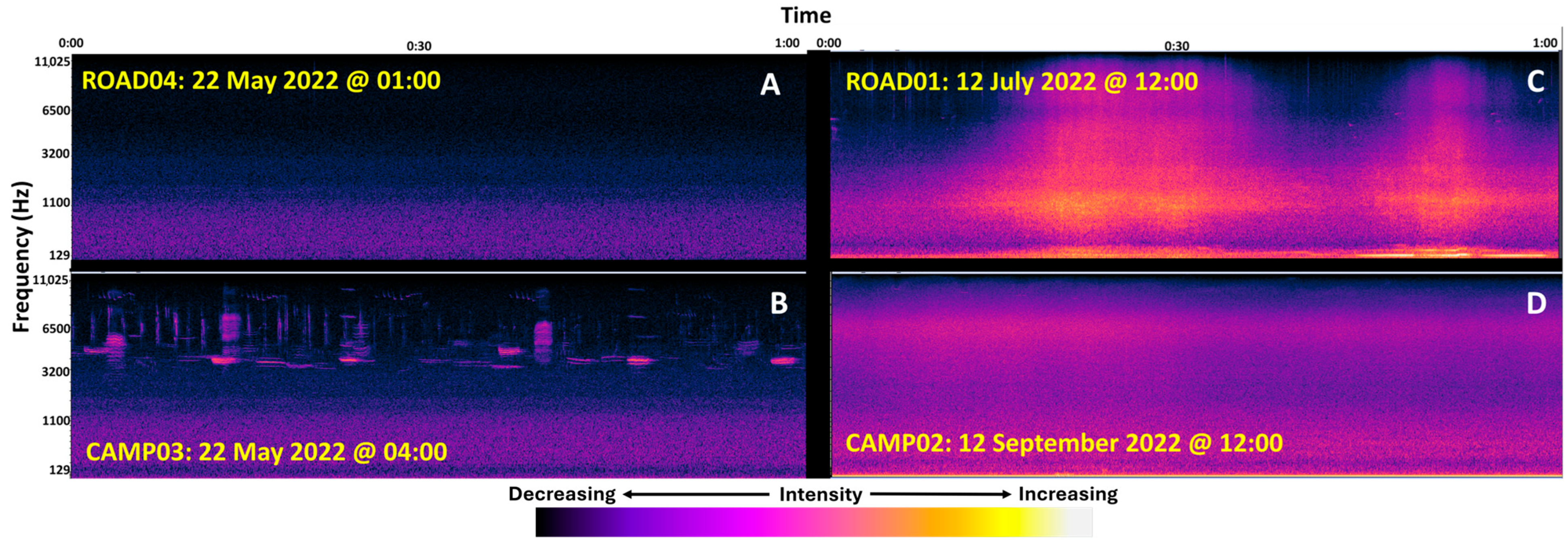
| Spectral Sonic Signature | |||
|---|---|---|---|
| Distance (m) | All Years | 2021 | 2022 |
| 60 | 247.1 | 239.4 | 255.5 |
| (245.5–248.6) | (237.2–241.6) | (253.3–257.7) | |
| 180 | 220.7 | 220.1 | 221.4 |
| (219.1–222.3) | (217.8–222.4) | (219.1–223.7) | |
| 450 | 207.7 | 206.4 | 209 |
| (206.0–209.4) | (204.0–208.8) | (206.6–211.4) | |
| 675 | 181.2 | 139.5 | 170.5 |
| (179.6–182.8) | (191.1–195.9) | (168.4–172.6) | |
| NDSHI | |||
|---|---|---|---|
| Distance (m) | All Years | 2021 | 2022 |
| 60 | −0.517 | −0.439 | −0.48 |
| (−0.525–−0.509) | (−0.447–−0.431) | (−0.486–−0.474) | |
| 180 | −0.556 | −0.547 | −0.552 |
| (−0.564–0.548) | (−0.556–−0.538 | (−0.558–−0.546) | |
| 450 | −0.604 | −0.589 | −0.596 |
| (−0.612–−0.596) | (−0.597–−0.580) | (−0.602–−0.590) | |
| 675 | −0.627 | −0.685 | −0.658 |
| (−0.635–−0.619) | (−0.692–−0.678) | (−0.663–−0.653) | |
| 2021 | ||||
|---|---|---|---|---|
| Month | 60 m | 180 m | 450 m | 675 m |
| May | 05 | 04 | 04 | 01 |
| June | 26 | 14 | 21 | 05 |
| July | 14 | 08 | 07 | 04 |
| August | 10 | 08 | 05 | 08 |
| Sepetember | 12 | 10 | 07 | 08 |
| October | 11 | 10 | 03 | 04 |
| Total | 78 | 54 | 47 | 30 |
| 2022 | ||||
| May | 01 | 00 | 02 | 00 |
| June | 19 | 07 | 20 | 00 |
| July | 23 | 07 | 22 | 08 |
| August | 22 | 12 | 21 | 09 |
| September | 11 | 13 | 05 | 08 |
| October | 05 | 11 | 00 | 03 |
| Total | 81 | 50 | 70 | 28 |
| Years Combined | ||||
| May | 02 | 01 | 01 | 01 |
| June | 24 | 09 | 05 | 01 |
| July | 21 | 07 | 04 | 06 |
| August | 17 | 09 | 08 | 06 |
| September | 11 | 14 | 08 | 04 |
| October | 06 | 07 | 04 | 02 |
| Total | 81 | 47 | 30 | 20 |
Disclaimer/Publisher’s Note: The statements, opinions and data contained in all publications are solely those of the individual author(s) and contributor(s) and not of MDPI and/or the editor(s). MDPI and/or the editor(s) disclaim responsibility for any injury to people or property resulting from any ideas, methods, instructions or products referred to in the content. |
© 2025 by the authors. Licensee MDPI, Basel, Switzerland. This article is an open access article distributed under the terms and conditions of the Creative Commons Attribution (CC BY) license (https://creativecommons.org/licenses/by/4.0/).
Share and Cite
Mullet, T.C.; Farina, A. Ecoacoustic Baseline of a Successional Subarctic Ecosystem Post-Glaciation Amidst Climate Change in South-Central Alaska. Diversity 2025, 17, 443. https://doi.org/10.3390/d17070443
Mullet TC, Farina A. Ecoacoustic Baseline of a Successional Subarctic Ecosystem Post-Glaciation Amidst Climate Change in South-Central Alaska. Diversity. 2025; 17(7):443. https://doi.org/10.3390/d17070443
Chicago/Turabian StyleMullet, Timothy C., and Almo Farina. 2025. "Ecoacoustic Baseline of a Successional Subarctic Ecosystem Post-Glaciation Amidst Climate Change in South-Central Alaska" Diversity 17, no. 7: 443. https://doi.org/10.3390/d17070443
APA StyleMullet, T. C., & Farina, A. (2025). Ecoacoustic Baseline of a Successional Subarctic Ecosystem Post-Glaciation Amidst Climate Change in South-Central Alaska. Diversity, 17(7), 443. https://doi.org/10.3390/d17070443






